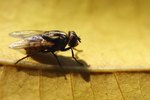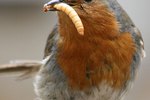
Although they're tiny at one-tenth to one-fifth of an inch long, fruit flies are among the leading insect contaminators of fruit and vegetable products in the United States. These small pests can be found anywhere a food source is: Homes, canneries, wineries, food-processing plants and pickle plants are prime habitats for these winged nuisances. Their numbers can escalate to full-blown infestations if circumstances allow.
Description and Life Cycle
Although they're small, they are quickly identified by their color and eyes. Most fruit flies are yellowish or tan in color, and most have red eyes. Their entire growth period from egg to adult can be completed in just over a week; eggs hatch sometimes in less than one day and their life spans last approximately one month. In the right conditions, an adult female can lay about 500 eggs.
Adult Feeding Habits
Once they emerge from their pupal stage, adult flies have only one thing on their minds: mating. They continue to feed, preferring overripe, fermenting fruits and vegetables. Other ideal food sources include pomace, fungi and the sludge left in drain pipes. After mating, the females search out suitable food sources for their tiny, wriggling larvae.
Egg-Laying and Larval Stage Feeding
Larvae feed on the same food as adults: fermenting and decaying vegetable matter. However, the adult females will seek out an egg-laying site on vegetable matter that will be ready in a day or two when her eggs hatch. The female lays groups of 25 or so eggs at a time, eventually reaching up to 500 eggs over the course of her life.
Controlling Their Feeding Habits
In North America, fruit flies pose little threat to the human population, although they can spread bacteria and disease-producing organisms. Because of this, they are considered major economical pests in some parts of the world. The best method of controlling their populations in your home is to discard overripe fruit or vegetables that are starting to decay. A common source of infestation is potatoes and onions, often stored in sizable quantities. One rotting onion or potato can feed a large population of fruit flies. Placing your fruits and vegetables in the refrigerator can prevent infestations. Because they're fond of trashcans, clean your indoor and outdoor trashcans with mild detergent or a diluted bleach solution. Prevent drain infestations by reducing the amount of food products that go down your drain; clean your drains thoroughly on a regular basis if you use a garbage disposal or occasionally put food materials through your kitchen sink.
References
- University of Kentucky Entomolgy: Fruit Flies
- Oklahoma State University Entomology and Plant Pathology: Fruit Flies, Drosophila spp.
- University of California Statewide Integrated Pest Management Program: Seasonal Development and Life Cycle - Fruit Fly
- The University of Georgia College of Agricultural and Environmental Sciences: Fruit Flies Are Annoying but Not Harmful
- University of Rhode Island Landscape Horticulture Program GreenShare: Vinegar and Fruit Flies
Photo Credits
-
Thinkstock Images/Comstock/Getty Images
Writer Bio
With a professional background in gardening, landscapes, pests and natural ecosystems, Jasey Kelly has been sharing her knowledge through writing since 2009 and has served as an expert writer in these fields. Kelly's background also includes childcare, and animal rescue and care.




